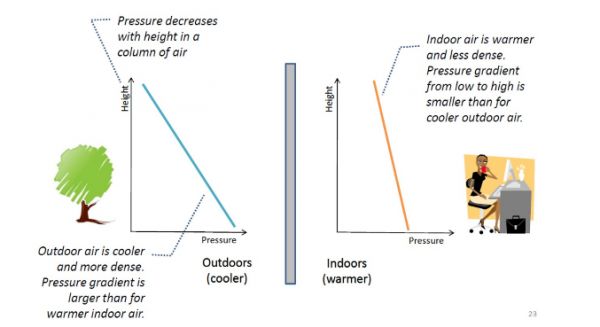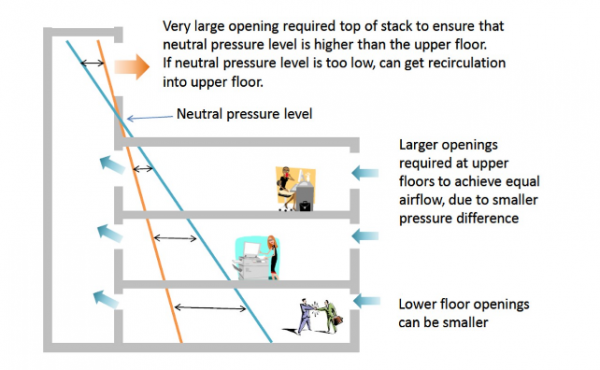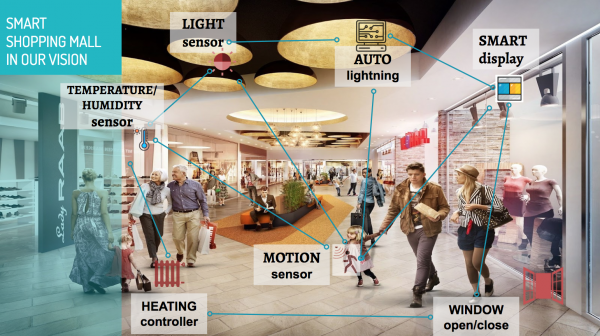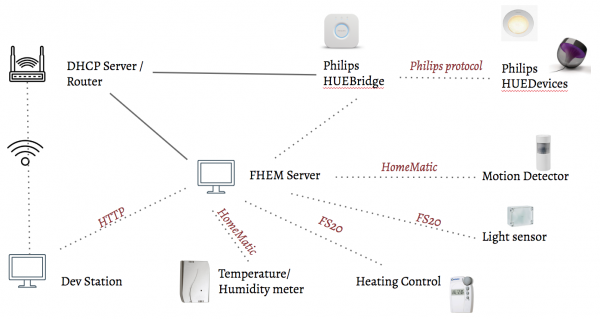meta data for this page
This is an old revision of the document!
Group 3: Pied Piper
| Name | Student ID |
|---|---|
| Amir RAHAFROUZ | 0000 |
| An PHAM | 0000 |
| Meruyert NURGAZY | 0000 |
| Sunnat SAMADOV | 0000 |
Problem Description
The importance of the concept of sustainability is increasing everyday; while the world population is increasing and the overall quantity of natural resources is decreasing. Built environments and the building sector is the area which uses an important amount of energy and materials that are produced by world resources.
Shopping centers are one of the most common structures in the world, which are developing continuously in the last decades. So the concept of sustainability in shopping center design has become a major problem. On the other hand, public awareness of environmental issues is growing around the world, and the environmental profile of a shopping mall forms an increasingly important part of its overall reputation.
Shopping malls which incorporate environmental considerations into their business operations will benefit from a better corporate image which helps distinguish them in the marketplace as forward - looking and responsible businesses who are sensitive to environmental issues. This project aims to make design proposals in shopping center public interiors to achieve more sustainable shopping centers.
Motivation
There are a number of areas which can be automated inside shopping centre in order to reduce energy consumption and consequently reduce carbon emissions.
- Increase energy efficiency
- Efficient scheduling
- Zoning and motion detection
- Renewable energy sources
- Efficient lighting
- Use of daylight
- Different light levels
- Reflection (mirror, heliostat)
- Cooling & Ventilation
- Water management
- Waste management
- Smart logistics
Project Vision
1. LIGHTING
Daylight: Energy consumption in shopping mall buildings, which have huge volumes and great number of users can be decreased by using day lighting. Studies found that average European city has more than 1500 sunny hours annually[1]. According to [2] annual electricity consumption of shopping centre is 21000 GJ and 25% of it is used for lighting[3]. Hence 21000GJ x 0.25 = 5250GJ energy is consumed yearly for lighting. (1.25GJ per hour) If we consider average mall's total number of operational hours per week as 80 hours, we receive approximately 4200 hours per year. And during 1500 hours out of operational 4200 hours shopping centres can use sunlight for lighting. If hypothetically consider that 30% of area in shopping centre can receive sunlight, the energy consumption can be found by the following formula: 1500h * 0.7 + (4200-1500)h = 3750h of energy use, 3750h * 1.25GJ = 4687.5GJ, means energy savings
5250 - 4687.5GJ = 562GJ.
Therefore, approximately 10.7% yearly saving on lighting electricity consumption can be reached just by shutting down lighting in the areas with windows during sunny days.
Mirror reflection: The simple use of mirrors in buildings is obvious. Since a mirror reflects light with virtually no loss, well-placed mirrors could be used to reflect the light, doubling the amount of ambient light in a room. Bulbs of half the normal wattage could be used, or half the number of fixtures could be used with no loss in light level. The potential energy savings would be enormous (50% in this simple example). Hypothetically, 50% of electricity saving is
21000GJ * 0.50 = 10500GJ
In addition to amplifying indoor light level, mirrors can be used for daylighting and heating. A heliostat is a device that includes a mirror, usually a plane mirror, which turns so as to keep reflecting sunlight toward a predetermined target, compensating for the sun's apparent motions in the sky [4].
Zoning and motion sensing: According to the motion detected certain zones will be activated and light level will be increased in these areas.
2. COOLING AND VENTILATION
Choosing the right shape, orientation, size of window and wisely exploiting thermal gradient inside the zones can lead to air movement which can partially or totally assure the required air change rates to maintain indoor air quality. On the other hand a smart natural air flowing can help to reduce overheating and dissipate hotness inside the massive layers of the envelope during the coolest hours of the night.
Researchers found that shopping malls spend 21% of total energy demand for cooling and 12% for ventilation purposes [5].
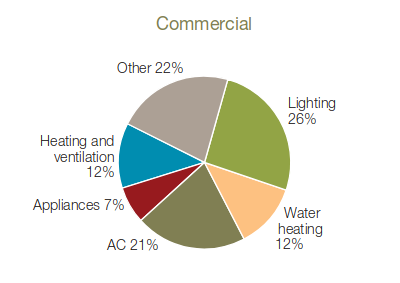
As displayed in Figure 1, heating and ventilation plus air conditioning needs shares ⅓ of total energy demand pattern of commercial buildings.
Research findings state that by using natural ventilation, overheating degree hours from April to October can be decreased by 27%, while air changes provided by natural ventilation reach 23% of total occupied hours and 83% of total closing hours in the same time period. Outcomes would be more reliable if wind data from a local weather station would be adopted [5]. If we consider working hours of shopping centre as 12h, then: 0.5*83+0.5*23 = 53% electricity usage for cooling can be reduced. As mentioned above, if we assume 21000GJ energy consumption of a mall, then ⅓ for heating and cooling is:
21000GJ / 3 = 7000 GJ.
By using natural ventilation we could reduce this number to:
7000GJ * (1-0.53) = 3290 GJ.
Amount of energy reduction would be:
7000GJ - 3290GJ = 3710GJ.
3. WATER MANAGEMENT
Harvesting rainwater and storing can help to control and decrease water consumption in shopping centres. Rainwater can be used for heat exchange, fountains inside and outside of malls and to flush the toilets and feed the urinals. a A pump and control system and some additional filtration must be installed to achieve the necessary flow of water. Studies found that usage of rainwater could reduce water consumption by 30% and save up to £612,000 in a 30 year timespan [7].
4. WASTE MANAGEMENT
197 million adults visit a shopping center each month in USA [6], while one shopping centre in London has 21 million annual visitor [7]. Hence, due to the increasing popularity and exponentially growing size of shopping centres, waste management in malls became a crucial problem. We propose to install an automated vacuum waste collection system, which is used in a city scale, but not in a smaller scale. However, the recent models of shopping malls can be considered as small cities. Therefore automation of waste management could have a number of benefits when installed in shopping centres/malls including:
- Waste storage space in lettable areas is significantly reduced as waste bins are automatically emptied as soon as they fill
- Manual handling and collection of waste including associated costs and insurances are almost eliminated.
- Reduced waste disposal costs with improved recycling.
- The systems are scalable and inlets can be easily added or relocated with centre expansions/renovations.
- Improved ‘green image’ as centre management are seen as leaders in green technology.
Installation of such system will reduce cost for waste management by twice and payback time for it is 5 years.
5. RENEWABLE ENERGY
Solar rooftops can be installed to maximize energy efficiency. American researchers found that electricity produced by rooftop panels on big box stores and shopping centers could offset the annual electricity use of these buildings by 42%, saving these businesses $8.2 billion annually on their electricity bills [8]. The typical solar payback period in the U.S. is between 6 and 8 years. If cost of installing solar is $20,000 and the system is going to save $2,500 a year on foregone energy bills, then solar panel payback or “break-even point” will be 8 years ($20,000/$2,500 = 8)[9].
6. OPTIMIZED SCHEDULING
Most shopping malls are only open about for about 12 hours per day, yet they are consuming energy 24/7. While some operations (such as security and refrigeration) may be necessary around-the-clock, others are not. Therefore, switches could be used to turn off all lighting and HVAC systems during night. We assume that optimized scheduling should give us 10% of electricity reduction which will be:
21000GJ * 0.1 = 2100 GJ
7. INTERNAL LOGISTICS
Automation of internal logistics one of the key areas which could make shopping mall smarter and more sustainable. Most of the stores operating in shopping centers have similar patterns of interactions with third-party operators. For example, each store needs packaging to be delivered, ordering cleaning service and handling stock management, etc.
Solution - Pros & Cons
1. Benefits
- Overall energy consumption reduction is around 16872 GJ:
562GJ(Daylight) + 10500GJ(Mirrors) + 3710 GJ(Natural Ventilation) + 2100 GJ(Optimized Scheduling) = 16872 GJ.
In percentage we reduce 80%:
16872/21000 * 100% = 80%
- Average electricity cost in Europe is 0.20euro per kWh, while 21000GJ ~= 5833333 kWh.
Therefore 5.833.333 * 0.20 = 1.166.666 euros can be saved.
In terms of carbon footprint, 752 tonnes of carbon emissions will be saved yearly.
- Average shopping mall is sized 40.000 m2. Sensors are needed for every 100m2 and 400 sensors are needed from each type.
| Equipment | Price (€) | Quantity | Overall cost(€) |
| Motion detector | 70 | 400 | 28.000 |
| Light dimmer | 40 | 400 | 16.000 |
| Temperature/Humidity Sensor | 55 | 400 | 22.000 |
| FHEM Server | 300 | 20 | 6000 |
| Mirrors | 1/m2 | 10.000m2 | 10.000 |
| Heliostats | 100 | 100 | 10.000 |
| Solar panels | 300 | 5000 | 1.500.000 |
Overall, around 1.600.000€ investment is needed for electricity automation. As a result:
- 10.7% lighting electricity savings on daylight.
- ~50% electricity savings by mirrors and heliostats.
- ~30% water consumption savings on rainwater harvesting.
- ~42% energy bills savings with solar panels.
2. Drawbacks
- Dependent on location
- Not feasible to integrate to existing malls
- Dependent on climate conditions of the region
- Long term payback
System Architecture
The shopping mall would be facilitated with sensors to provide data on user movement, air condition (light, temperature, humidity) along with automatic heating/lighting controlling system.
In order to demonstrate the scenarios of a smart shopping mall, we've implemented the following architecture:
Using FHEM server, we've connected with sensors (HomeMatic temperature/humidity and motion sensors, FS20 Light Sensor and Heating Controller) and Philips smart lights. The DHCP server has also been set up to provide connections between development station, FHEM server and Philips HUEBridge (to control Philips HUE devices).
Implementation
Source code goes here
Protocol for Home Automation
Discuss one protocol here
Documentation
Include presentation, report and poster here

